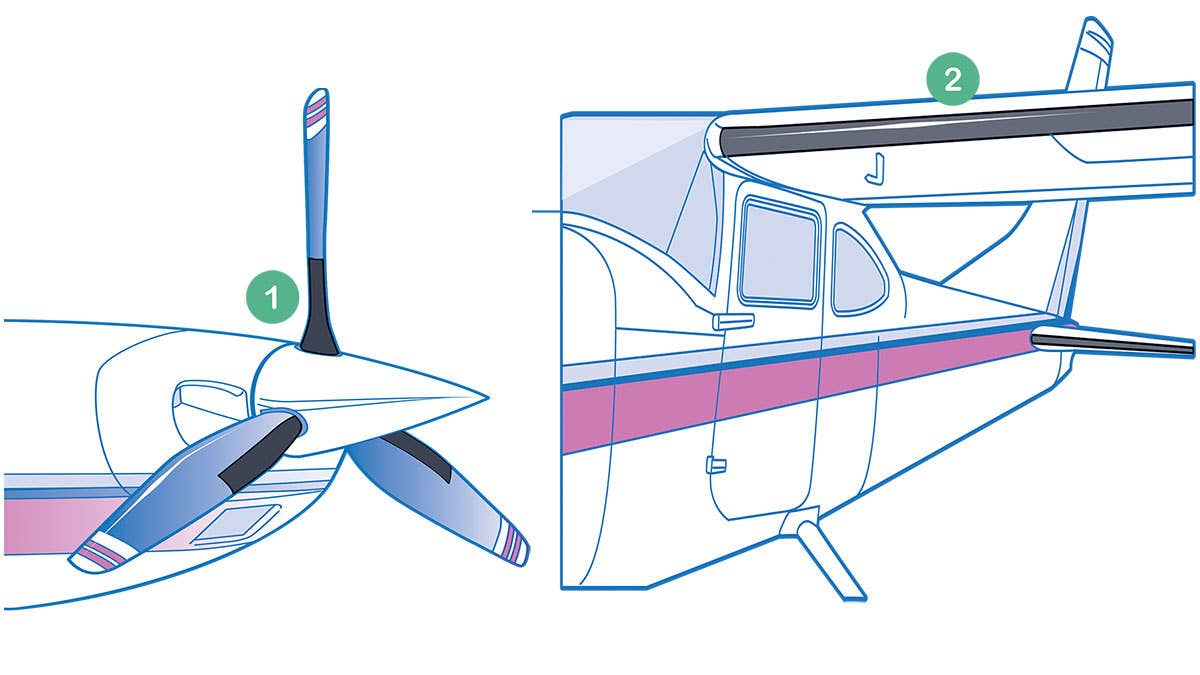
1) Electric prop deicers must be activated before entering icing conditions to have enough time to heat the propeller blades. 2) Despite their efficiency, there are limits to how much ice pneumatic boots are capable of removing from wing leading edges. Tim Barker
With winter nearly in full swing north of the equator, it’s only a matter of time before instrument-rated pilots will need to make decisions about how to escape from icing situations, whether that be before takeoff or while en route. Ice adds weight and acts as a lift spoiler across wings and tail surfaces. Ice can also affect engine operations for all aircraft. Ice protection is broadly categorized as either anti- or deicing, depending on the equipment installed and the certification of the aircraft.
When it comes to protecting an aircraft from icing, there are few absolutes, only guidelines about when to expect ice. In visible moisture when the outside air temperature is below 37 degrees, pilots should expect to see the white stuff begin to stick. While icing equipment is certainly helpful in ridding the airframe or power plant of ice, the best strategy is to leave the altitude or weather system producing the ice as soon as possible. High-performance aircraft hold the advantage here when it comes to escape maneuvers.
Deicer boots — Boots are rubber sleeves attached to the leading edges of the wings and the horizontal stabilizer, powered by pneumatic air. Boots cyclically expand and contract when activated by the pilot to break the grip of the ice attempting to spoil lift. Boots expand sequentially in such a way that not all sections of the airfoil are deiced at the same time. The trick is not to wait too long to activate them lest they be unable to keep up with a rapid accumulation of ice.
Heated leading edges — Most transport-category aircraft use leading edges heated from the inside by bleed air siphoned from their turbine engines and then piped to the appropriate location. The airfoils are heated before the aircraft encounters ice. One drawback to bleed-air heating of the leading edges is the power it draws, which can limit aircraft performance, such as at takeoff.
TKS — This system covers the lift-producing leading edges with a fine wire mesh that includes holes almost impossible to see with the human eye. As a TKS-equipped aircraft approaches icing conditions, the pilot activates the system, which then squirts an anti-icing fluid out the holes along the leading edges to prevent the buildup of ice.
Pitot tube heat — Ice adhering to pitot tubes exposed to the slipstream and water-laden atmosphere are just as susceptible to icing as airfoils. Pitot tubes, stall vanes and outside air temperature gauges can, in an era of glass-cockpit aircraft carrying extremely sophisticated sensors, quickly become useless or error-prone should they become encased in ice. On sophisticated aircraft, these tubes are usually electrically heated, often automatically before encountering ice. On a Cessna 172 or a Piper Archer, for example, a heated pitot tube is pretty much standard equipment, except the pilot must remember to turn it on before encountering icing conditions.
Engines — Piston engines demand a free flow of air to operate, a flow that icing can disturb. Piston aircraft will normally offer the pilot an alternate air-source option to suck air from a location out of the slipstream in the event of an icing encounter. Turbine engines have no love for ice either, and are usually protected by electrically heated inlets that must be switched on before the ice begins forming.
Propellers — Because propellers are airfoils, they too must be protected from ice accumulation lest they lose their ability to produce thrust. Modern aircraft use electrical power to prevent or shed ice attempting to adhere to the blades. In earlier days, propellers were often protected by a system that squirted alcohol on the blades to shed ice.

Sign-up for newsletters & special offers!
Get the latest FLYING stories & special offers delivered directly to your inbox






